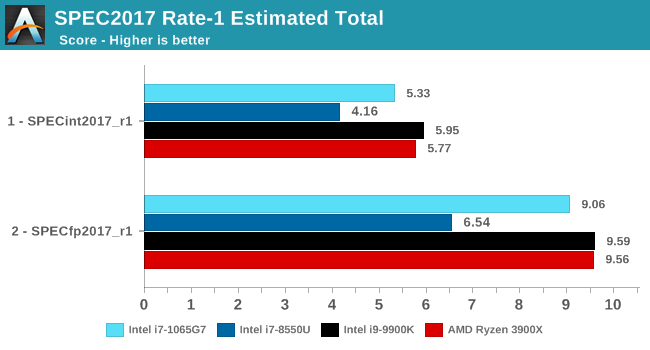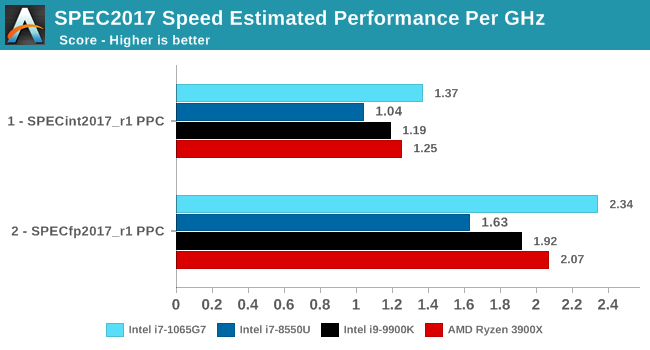The Ice Lake Benchmark Preview: Inside Intel's 10nm
by Dr. Ian Cutress on August 1, 2019 9:00 AM EST- Posted in
- CPUs
- Intel
- GPUs
- 10nm
- Core
- Ice Lake
- Cannon Lake
- Sunny Cove
- 10th Gen Core
Section by Andrei Frumusanu
SPEC2017 and SPEC2006 Results (15W)
SPEC2017 and SPEC2006 is a series of standardized tests used to probe the overall performance between different systems, different architectures, different microarchitectures, and setups. The code has to be compiled, and then the results can be submitted to an online database for comparsion. It covers a range of integer and floating point workloads, and can be very optimized for each CPU, so it is important to check how the benchmarks are being compiled and run.
We run the tests in a harness built through Windows Subsystem for Linux, developed by our own Andrei Frumusanu. WSL has some odd quirks, with one test not running due to a WSL fixed stack size, but for like-for-like testing is good enough. SPEC2006 is deprecated in favor of 2017, but remains an interesting comparison point in our data. Because our scores aren’t official submissions, as per SPEC guidelines we have to declare them as internal estimates from our part.
For compilers, we use LLVM both for C/C++ and Fortan tests, and for Fortran we’re using the Flang compiler. The rationale of using LLVM over GCC is better cross-platform comparisons to platforms that have only have LLVM support and future articles where we’ll investigate this aspect more. We’re not considering closed-sourced compilers such as MSVC or ICC.
clang version 8.0.0-svn350067-1~exp1+0~20181226174230.701~1.gbp6019f2 (trunk)
clang version 7.0.1 (ssh://git@github.com/flang-compiler/flang-driver.git
24bd54da5c41af04838bbe7b68f830840d47fc03)-Ofast -fomit-frame-pointer
-march=x86-64
-mtune=core-avx2
-mfma -mavx -mavx2
Our compiler flags are straightforward, with basic –Ofast and relevant ISA switches to allow for AVX2 instructions. Despite ICL supporting AVX-512, we have not currently implemented it, as it requires a much greater level of finesse with instruction packing. The best AVX-512 software uses hand-crafted intrinsics to provide the instructions, as per our 3PDM AVX-512 test later in the review.
For these comparisons, we will be picking out CPUs from across our dataset to provide context. Some of these might be higher power processors, it should be noted.
SPECint2006

Amongst SPECint2006, the one benchmark that really stands out beyond all the rest is the 473.astar. Here the new Sunny Cove core is showcasing some exceptional IPC gains, nearly doubling the performance over the 8550U even though it’s clocked 100MHz lower. The benchmark is extremely branch misprediction sensitive, and the only conclusion we can get to rationalise this increase is that the new branch predictors on Sunny Cove are doing an outstanding job and represent a massive improvement over Skylake.
456.hmmer and 464.h264ref are very execution bound and have the highest actual instructions per clock metrics in this suite. Here it’s very possible that Sunny Cove’s vastly increased out-of-order window is able to extract a lot more ILP out of the program and thus gain significant increases in IPC. It’s impressive that the 3.9GHz core here manages to match and outpace the 9900K’s 5GHz Skylake core.
Other benchmarks here which are limited by other µarch characteristics have various increases depending on the workload. Sunny Cove doubled L2 cache should certainly help with workloads like 403.gcc and others. However because we’re also memory latency limited on this platform the increases aren’t quite as large as we’d expect from a desktop variant of ICL.

In SPECfp2006, Sunny Cove’s wider out-of-order window can again be seen in tests such as 453.povray as the core is posting some impressive gains over the 8550U at similar clocks. 470.lbm is also instruction window as well as data store heavy – the core’s doubled store bandwidth here certainly helps it.

Overall in SPEC2006, the new i7-1065G7 beats a similarly clocked i7-8550U by a hefty 29% in the int suite and 34% in the fp suite. Of course this performance gap will be a lot smaller against 9th gen mobile H-parts at higher clocks, but these are also higher TDP products.
The 1065G7 comes quite close to the fastest desktop parts, however it’s likely it’ll need a desktop memory subsystem in order to catch up in total peak absolute performance.

Performance per clock increases on the new Sunny Cove architecture are outstandingly good. IPC increases against the mobile Skylake are 33 and 38% in the integer and fp suites, though we also have to keep in d mind these figures go beyond just the Sunny Cove architecture and also include improvements through the new LPDDR4X memory controllers.
Against a 9900K, although apples and oranges, we’re seeing 13% and 14% IPC increases. These figures likely would be higher on an eventual desktop Sunny Cove part.
SPEC2017



The SPEC2017 results look similar to the 2006 ones. Against the 8550U, we’re seeing grand performance uplifts, just shy of the best desktop processors.

Here the IPC increase also look extremely solid. In the SPECin2017 suite the Ice Lake part achieves a 14% increase over the 9900K, however we also see a very impressive 21% increase in the fp suite.
Overall in the 2017 suite, we’re seeing a 19% increase in IPC over the 9900K, which roughly matches Intel’s advertised metric of 18% IPC increase.










261 Comments
View All Comments
KAlmquist - Friday, August 2, 2019 - link
So Intel has produced a significant jump in IPC for for the first time in a long while, but they aren't going to bring it to the desktop any time soon. 7nm is targeted for 2021, but even if it is delivered on time the plan is to initially use it for data center products (a General-Purpose Graphics Processing Unit, to be followed by some Xeon processors). I've been expecting Ryzen 3XXX prices to fall over the next six months, but AMD may have no reason to reduce prices if Intel isn't planning to compete.Comagnum - Thursday, August 1, 2019 - link
These processors look.. unimpressive.PeachNCream - Thursday, August 1, 2019 - link
Yup.Arbie - Thursday, August 1, 2019 - link
The gaming results section would really benefit from a clear statement of the video resolution in each case (I didn't see that anywhere in the article), and at least one comparison to a discrete graphics card.Ian Cutress - Thursday, August 1, 2019 - link
It's there in the title of the graphArbie - Friday, August 2, 2019 - link
I've been through too many generations of monitors, I guess. The default now would be 16:9 so the title bar numbers are clear enough. Except World of Tanks resolution wasn't apparently listed; but that's rare enough that I doubt it would be much use in comparing to other GPUs.Elstar - Thursday, August 1, 2019 - link
This appears to be an editing error:"POPCNT Microcode 50% faster than SW (under L1-D size)"
The comment must apply to something other than POPCNT (which is trivial to implement). I'd wager this comment refers "REP MOVS" given the next line is about "REP STOS".
nivedita - Thursday, August 1, 2019 - link
“Throughout most of the last decade, Intel has kept the same cache configuration among its server cores with very few changes, aside from improving the micro-op cache through Sandy Bridge today, but with Sunny Cove, we get some key updates.“Didn’t the cache hierarchy change considerably in skylake, with l2 growing and l3 becoming non-inclusive? Or am I misremembering?
Elstar - Thursday, August 1, 2019 - link
You're thinking about the server variant of Skylake. This article is about the "client" variant of Skylake (i.e. the one with integrated graphics, etc) and therefore the commentary about caches is valid.psychobriggsy - Thursday, August 1, 2019 - link
1. Still months from availability, so this is a very early preview. This is obviously going to bring up cries of paper launch and Intel marketing, but no website would have turned it down. I don't think the article is kind.2. Gains are negligible.
3. Lower base clocks, all-core turbo and 1C turbos are highly concerning for the 10nm process compared to Whiskey Lake.
4. 'extra binning required' for the 28W SKU means that not many dies can make this, this is the 10nm limit for Intel.
5. AVX512 is a beast
6. Better GPU drags Intel from being way-behind to not being an embarrassment.